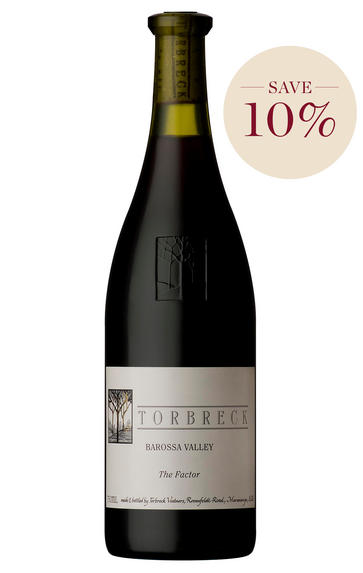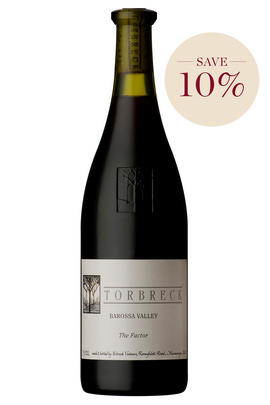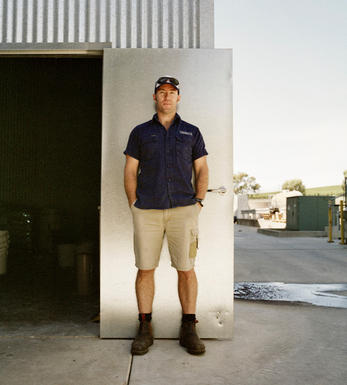
2017 Torbreck, The Factor, Barossa Valley, Australia

Critics reviews
Opaque ruby. Smoke-tinged black and blue fruit, incense, cola and roasted coffee aromas are sharpened by a building suggestion of exotic pepper spices. Intensely concentrated yet lithe on the palate, offering intense cassis, bitter cherry and spice cake flavours that turn sweeter on the back half. It finishes with excellent clarity, mounting tannins and strong, spicy thrust, leaving resonating vanilla and mocha notes behind.
Drink 2023 - 2033
Josh Raynolds, Vinous.com (December 2021)
Aged in 50% new oak, Tobreck's 2017 The Factor boasts hickory-like smoky aromas, plus plum and blackberry fruit. It's full-bodied and firmly built, finishing with hints of chocolate, liquorice and dusty tannins. Give it another 2-3 years in the cellar, then drink it over the next decade and a half.
Drink 2022 - 2035
Joe Czerwinski, Wine Advocate (November 2019)
A blend of parcels that sees a 24-month elevage in barriques and has Western Barossa black fruit, a strong, savoury, tarry thread, spiced earth and orange peel. Very velvety tannins, packed with rich dark fruit that drive so so long. The cooler vintage has dialled this in nicely. So much concentrated flavour. Seamless texture. Excellent length. A great Factor!
Drink or hold
James Suckling, JamesSuckling.com (December 2020)
About this WINE

Torbreck
Torbreck was established in 1994 and is located at Marananga on the western ridge of the Barossa Valley. It is named after a forest situated just south of Inverness in the Highlands of Scotland. Founded by David Powell, a former lumberjack who worked in various vineyards to hone his oenological skills, Torbreck’s first releases in 1997 of a 1995 Runrig (Shiraz/Viognier) and 1996 The Steading (Grenache/Mataro/Shiraz) were greeted with rapturous applause by critics and connoisseurs alike. The winery is overseen by Senior Winemaker Craig Isbel and his team.
The overwhelming majority of his vines are dry-grown, nearly all are 100 - 165 years old and are tended and harvested by hand. The wines have an extraordinary combination of power, intensity, complexity and great finesse.

Barossa Valley
Barossa Valley is the South Australia's wine industry's birthplace. Currently into its fifth generation, it dates back to 1839 when George Fife Angas’ South Australian Company purchased 28,000 acres at a £1 per acre and sold them onto landed gentry, mostly German Lutherans. The first vines were planted in 1843 in Bethany, and by the 1870s – with Europe ravaged by war and Phylloxera - Gladstone’s British government complemented its colonies with preferential duties.
Fortified wines, strong enough to survive the 20,000km journey, flooded the British market. Churchill followed, between the Wars, re-affirming Australia’s position as a leading supplier of ‘Empire wines’. After the Second World War, mass European immigration saw a move to lighter wines, as confirmed by Grange Hermitage’s creation during the 1950s. Stainless-steel vats and refrigeration improved the quality of the dry table wines on offer, with table wine consumption exceeding fortified for the first time in 1970.
Averaging 200 to 400 metres’ altitude, the region covers 6,500 hectares of mainly terra rossa loam over limestone, as well as some warmer, sandier sites – the Cambrian limestone being far more visible along the eastern boundary (the Barossa Ranges) with Eden Valley. Following a diagonal shape, Lyndoch at the southern end nearest Gulf St Vincent is the region’s coolest spot, benefiting from sea fogs, while Nuriootpa (further north) is warmer; hot northerlies can be offset by sea breezes. The region is also home to the country’s largest concentration of 100-year-old-vine Shiraz, Grenache and Mourvedre.
Barossa Valley Shiraz is one of the country’s most identifiable and famous red wine styles, produced to a high quality by the likes of Rockford, Elderton, Torbreck and Dean Hewitson. Grenache and Mourvèdre are two of the region’s hidden gems, often blended with Shiraz, yet occasionally released as single vineyard styles such as Hewitson’s ‘Old Garden’, whose vines date back to 1853. Cabernet Sauvignon is a less highly-regarded cultivar.
Wines are traditionally vinified in open concrete fermenters before being cleaned up and finished in American and French oak barrels or ‘puncheons’ of approximately 600 litres. Barossa Shiraz should be rich, spicy and suave, with hints of leather and pepper.

Syrah/Shiraz
A noble black grape variety grown particularly in the Northern Rhône where it produces the great red wines of Hermitage, Cote Rôtie and Cornas, and in Australia where it produces wines of startling depth and intensity. Reasonably low yields are a crucial factor for quality as is picking at optimum ripeness. Its heartland, Hermitage and Côte Rôtie, consists of 270 hectares of steeply terraced vineyards producing wines that brim with pepper, spices, tar and black treacle when young. After 5-10 years they become smooth and velvety with pronounced fruit characteristics of damsons, raspberries, blackcurrants and loganberries.
It is now grown extensively in the Southern Rhône where it is blended with Grenache and Mourvèdre to produce the great red wines of Châteauneuf du Pape and Gigondas amongst others. Its spiritual home in Australia is the Barossa Valley, where there are plantings dating as far back as 1860. Australian Shiraz tends to be sweeter than its Northern Rhône counterpart and the best examples are redolent of new leather, dark chocolate, liquorice, and prunes and display a blackcurrant lusciousness.
South African producers such as Eben Sadie are now producing world- class Shiraz wines that represent astonishing value for money.


Buying options
Add to wishlist
Description
The price of the 75cl bottle, reduced from £81 previously, includes a 10% discount. This offer does not apply to BBX listings.
This has a beautiful, brooding nose with bundles of Inky black fruit and dark black cherries on show. A second whirl of the glass provides undertones of dark chocolate and hints of pepper and sweet spice. It is full-bodied on the palate with tannins that are bristling and robust. You can almost imagine the grape’s laborious struggle within the heat of their Northern ironstone/sandy soils. Dark, dense and powerful but without over-extraction, the alcohol is tucked away exquisitely - Interwoven between layer upon layer of complex succulent fruit.
The 2017 vintage will be remembered mainly for its incredible aromatics, and this is an exceptional Barossa Valley Shiraz with a concentrated and fine finish. Described by winemaker Ian Hongell over webcam as “Classic Steak Red”. I agree, but the steak would have to be something rather special to do this justice! Phenomenal Australian Red Wine.
Drink 2024 - 3035+
Daniel Martin, Private Client Manager, Berry Bros. & Rudd
wine at a glance
Delivery and quality guarantee